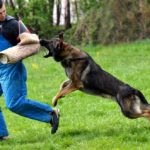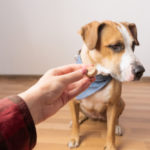Most dogs have a natural hunting instinct, meaning they’re always ready to pounce on something they see as a tasty meal, regardless of how alive that meal might be.
That instinct was all well and good hundreds of years ago when dogs had to fight for their own food, however it’s an annoying habit for the modern day dog to have when all of its food is provided by you, their lovely owner.
Not only is it annoying to have your dog sprint uncontrollably away from you towards a rabbit, but it can obviously be dangerous to both the rabbit and the dog.
Dogs aren’t the most careful creatures when they’re chasing something, so there’s every chance they could run into a road or something that could hurt them.

That’s why it’s super important to train your dog not to attack rabbits, especially if you have some in your backyard at home or walk them in an area that has small animals around.
In this article, we’ll go over some of the best ways to train your dog out of this habit. For all of the methods we cover, it’s best if your dog already knows some of the simple training commands like ‘sit’, ‘stay’ and ‘look’.
Once they have these mastered, it’ll be a whole lot easier to train them out of attacking rabbits.
Method 1: Desensitization
The best way to get a dog to stop going after rabbits is to make them not want to do it in the first place. With this method, you’ll be able to train your dog to completely ignore a rabbit when you walk past it.
1. Preparing your equipment – First, you’ll need a toy rabbit or something similar to mimic something your dog will see and want to chase after when out on a walk.
2. Keep the dog and rabbit at a safe distance – Have your dog on a leash in the same room as the toy rabbit. You’ll need to make sure they’re a sufficient distance from each other that the dog will eventually ignore the rabbit.
Reward your dog when they are clearly paying no attention to the rabbit in the room.
3. Get closer – Now, you want to move slightly closer to the rabbit with your dog still on a leash, only a few steps at a time. If the dog starts to show signs that they’re getting interested in the rabbit or about to jump at it, use the ‘look’ command to refocus their attention on you.
Reward the dog whenever their attention turns away from the rabbit or if they don’t seem interested in it at all.
4. Develop a tolerance – As you progress with this method, try to get the dog closer and closer to the rabbit without them paying it any attention. Eventually, you might even be able to take the dog off the leash and they’ll focus their attention on you, completely ignoring the rabbit.
Method 2: Using The ‘Sit’ Command
Dogs get excited about chasing small animals, even more so than they do about catching the animal itself. This is what causes them to act so crazily and lose focus on your commands.
With this method, you eliminate the excitement built up by chasing a rabbit by forcing your dog to sit before they can set off.
1. Preparing your dog – All you’ll need for this method is a nice, quiet space that doesn’t have any distractions and some treats to give your dog as a reward for good behaviour. Allow your dog to sniff the treat in your hand but don’t let them eat it.
2. Sitting your dog down – Now that your dog has the scent of that treat racing through their mind, raise it slowly above their head, always showing the treat to them. If the dog jumps up, hide the treat from them until they calm down.
Tell your dog to ‘sit’ and don’t give them the treat until their butt hits the ground.
3. Develop a tolerance – As you develop this method, you should be able to move further and further away from your dog with them still being able to sit on command.
You should also make your dog wait a little bit longer before giving them the treat each time you practice. This is important for developing full control over your dog for when they see a real rabbit out in the world.
4. Remove the treat – Once you feel you have full control over your dog using the ‘sit’ command, try practicing a few times without giving them the treat as a reward.
This teaches the dog that it’s not guaranteed that they’ll be rewarded every time and that this is how you expect them to behave on command.
Method 3: The Rock Bottle Technique
This technique was originally developed to stop dogs from chasing sheep when walking through farmlands. However, the principle is still the same with smaller animals like rabbits and it’s super effective!
It works by deterring your dog from behaving badly using some clever auditory tricks. It’s also worth noting that this technique can be used to train a dog out of pretty much any bad behaviour, but if you use it too often, the effect will be less powerful, so be careful not to overuse it.
It should also be noted that this technique uses aversive methods, which are not as effective as positive reinforcement ones like the first two on our list. You should only resort to this method if you’re really struggling to control your dog around rabbits.
1. Prepare your equipment – For this method, you’ll need any empty water bottle (any small, plastic bottle will do) and fill it about halfway with small rocks or pebbles.
2. Teaching the ‘no’ command – This training method doesn’t take a lot of preparation and the best way to initiate it is to start on a walk. Establish an area where you want your dog to stay close to you.
Then, whenever the dog tries to run too far away from you, shout ‘no’ and shake the bottle of rocks hard. Dogs naturally hate this sound, so it’ll stop them in their tracks from whatever they were doing.
Once they’ve stopped, use the ‘come’ command to bring your dog back to close proximity and continue walking.
3. Practice with rabbits – If you’re not confident in your dog’s ability to follow these commands when a real rabbit is nearby, practice this with a toy rabbit at home first.
Quite simply, whenever your dog looks towards or shows any interest in a rabbit, shout ‘no’ and shake the bottle hard. Then, same as before, get them to return to you and continue walking, repeating the process if they show further interest.
4. Develop a tolerance – Eventually, your dog will associate the word ‘no’ with that awful rock shaking noise and stop what they’re doing at the mere mention of the word.
Sometimes it can still be effective to show the rock bottle to your dog without shaking it. This acts as a stern reminder of what will happen if they misbehave and will discourage them from running off.
Final Thoughts
Hopefully, at least one of these methods will work wonders on your dog and have them behave much better around rabbits and other small animals.
It’s possible that not all of these methods will work on your dog, however these tricks are pretty universal, so there should be something on this list that works for you.
Now, you can enjoy taking your little buddy out on walks without fear of them terrorizing the local wildlife!
- 8 Signs That Your Dog Is In Heat - November 8, 2022
- Why Is My Dog Whining Whilst Carrying A Toy In Their Mouth? - August 17, 2022
- Reasons Why Your Dog’s Poop Is White And What To Do About It - August 17, 2022









